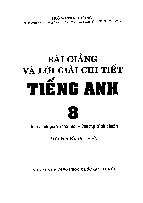













Preview text:
Unit 2 LIFE IN THE COUNTRYSIDE
LESSON 3: A CLOSER LOOK 2
LESSON 3: A CLOSER LOOK 2 WARM-UP Making comparison PRESENTATION Comparative adverbs
Task 1: Write the comparative forms of the adverbs in the table below.
Task 2: Complete the sentences with the comparative forms of PRACTICE the adverbs in brackets.
Task 3: Complete the sentences with suitable comparative
forms of the adverbs from the box.
Task 4: Read the situations and complete the sentences using the comparative forms. PRODUCTION
Task 5: Work in pairs. Ask and answer to find out who… Wrap-up CONSOLIDATION Homework WARM-UP MAKING COMPARISON PRESENTATION
– For most adverbs (often with two or more syllables), we make comparative
forms by adding more. Example: slowly → more slowly
carefully → more carefully
– For adverbs that have the same forms as adjectives like fast, hard, soon, etc.,
we make comparative forms by adding -er. Example: fast → faster hard → harder – Some irregular adverbs: well → better badly → worse PRACTICE
1 Write the comparative forms of the adverbs in the table below. PRACTICE
2 Complete the sentences with the comparative forms of the adverbs in brackets.
1. Mai dances (beautifully) _______________ than Hoa does.
2. Please write (clearly) _____________. I can’t read it.
3. Life in the city seems to move (fast) _____ than that in the countryside.
4. If you want to get better marks, you must work much (hard) ______.
5. Today it’s raining (heavily) ____________ than it was yesterday. PRACTICE
3 Complete the sentences with suitable comparative forms of the adverbs from the box. early soundly fast carefully quietly
1. After his accident last month, he is driving _____________ more carefully now.
2. A horse can run ______ faster than a buffalo.
3. You’re too loud. Can you speak a bit ____________? more quietly
4. After working hard all day on the farm, we slept ____________ more soundly than ever before.
5. The farmers started harvesting their crops ______ earlier than expected. PRACTICE
Read the situations and complete the sentences using the comparative forms of the 4 adverbs in brackets.
1. The red car can run 200 km/h while the black car can run 160 km/h.
The red car can run _______________ faster than ___ the black ___ car __. (fast)
2. Nick can jump 1.5 m high while Tom can jump only 1.3 m.
Nick can jump _______________ higher than T ___ om (c _. an) (high) PRACTICE
3. Mai and hoa both did well on the exam. Hoa got 80% of the answers correct and Mai got 90%. Mai did _______________ better on the ex ___ am t______ han ___ Hoa . (well)
4. My dad expected the workers to arrive at 7 a.m., but they arrived at 6:30 a.m. The workers arrived ____ earli____ er ____ than m _______ y dad e ______ xpected _. (early)
5. The buses run every 15 minutes. The trains run every 30 minutes.
The buses run ________________ more frequentl ___ y than ______ the tr ___ ains . (frequently) PRODUCTION
Work in pairs. Ask and answer to find out who: 5 – can run faster Example:
A: How fast can you run? – can jump higher
B: I can run 15 kilometres an hour. – stays up later at night
A: OK, you can run faster than me.
– gets up earlier in the morning
Report your results to the class. CONSOLIDATION 1 Wrap-up
What have we learnt in this lesson?
✓ How to use the comparative forms of adverbs CONSOLIDATION 2 Homework
➢ Do exercises in the workbook.
Website: hoclieu.vn
Fanpage: facebook.com/www.tienganhglobalsuccess.vn/
Document Outline
- Slide 1
- Slide 2
- Slide 3
- Slide 4
- Slide 5
- Slide 6
- Slide 7
- Slide 8
- Slide 9
- Slide 10
- Slide 11
- Slide 12
- Slide 13
- Slide 14




